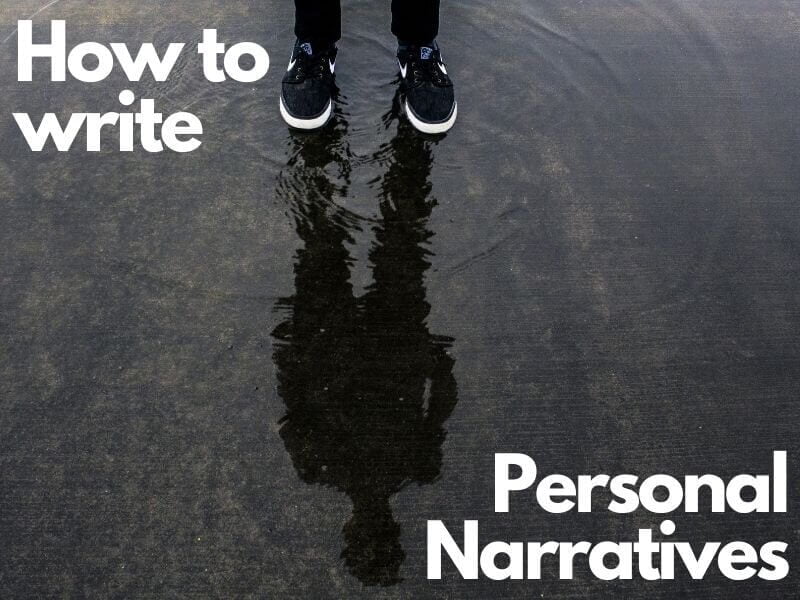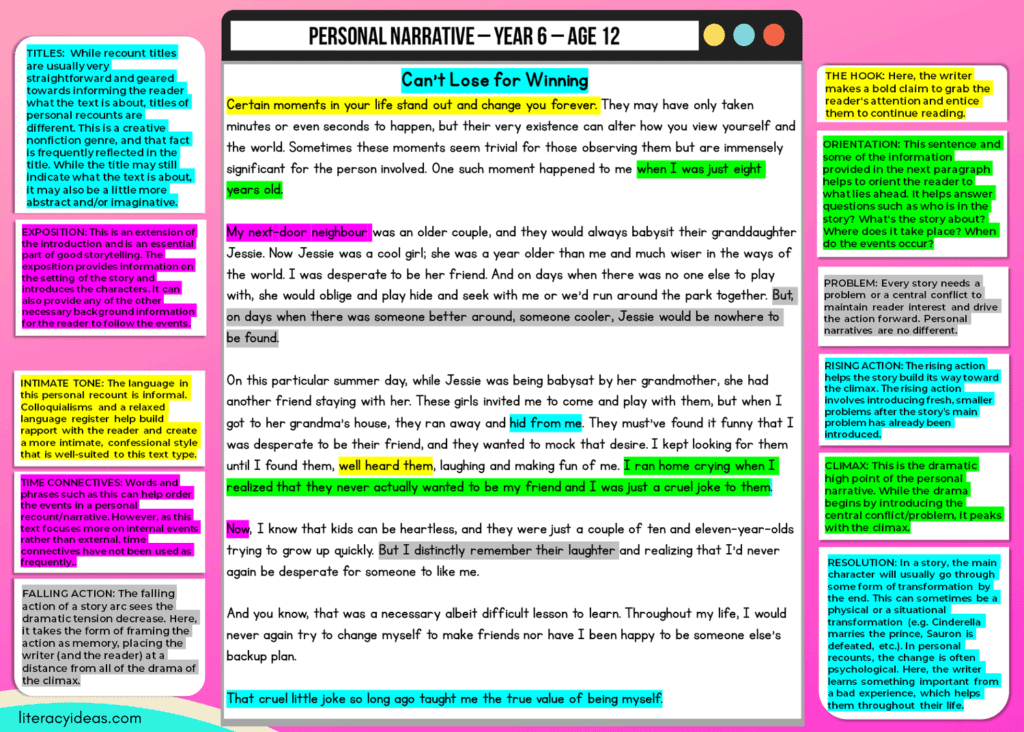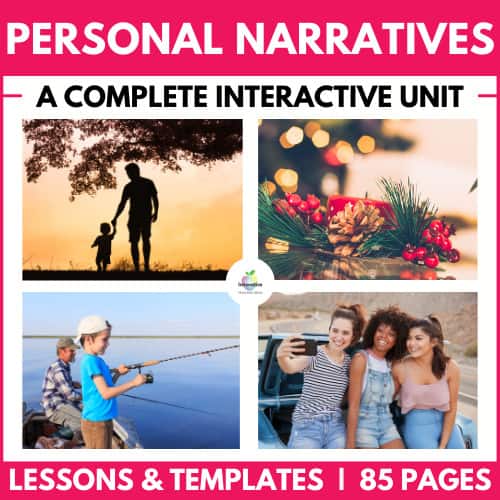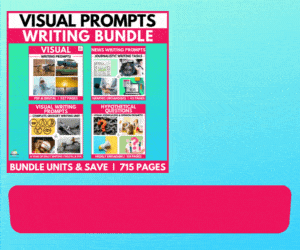
WHAT IS A PERSONAL NARRATIVE?

A Personal Narrative recounts an event or experience from the writer’s life in story form and often in intimate detail. This text type not only relates to the events happening around the author but also often reveals the writer’s inner thoughts and emotions also.
A personal narrative can be understood as nonfiction storytelling based on the writer’s thoughts, feelings, and experiences. Told in the first person, the writer draws on their life events to construct a story.
Combining elements of nonfiction recount writing with introspection and the frequent use of literary devices more commonly associated with fiction and poetry, a personal narrative can be best understood as a type of creative nonfiction.
PERSONAL NARRATIVE VERSUS A PERSONAL RECOUNT: SO WHAT’S THE DIFFERENCE?
Personal narratives are also frequently referred to as personal recounts. They share much in common but are unique text types, so let’s explore how they compare and contrast.
When we first instruct our students to write stories based on the events of their own lives, they will inevitably write simple recounts. These recounts are based on retelling personal incidents of their lives but lack the depth we can typically expect to find in a personal narrative.
While personal narratives also recount events from the writer’s life, with greater emphasis placed on exploring the writer’s thoughts and feelings on these events rather than just what happened.
A personal narrative is a means for the writer to explore the meaning of the events in their life. It is, at its core, an introspective and creative endeavor that focuses as much on the interior life of the writer as it does on external events.
While the conclusion of a traditional recount usually provides some of the writer’s insights, in a personal narrative, these are woven throughout the text.
STRUCTURE AND FEATURES OF A PERSONAL NARRATIVE
PERSONAL NARRATIVE STRUCTURE
ORIENTATION Explain the who, what, when, and where of the experience in your introduction to your audience.
FOCUS Mainly focus on meaningful events.
CHRONOLOGY Events are described in the sequence in which they occurred.
ORGANIZATION Relevant information is organized into paragraphs
INSIGHT & MEANING Include personal comments, opinions or interpretations of the experience or event in your personal narrative.
PERSONAL NARRATIVE FEATURES
TENSE The first and third person are used most frequently and recall is always written in the past tense. Present tense can be used for analysis and opinion.
NOUNS Use proper nouns to refer to specific people, places times and events
VOICE Both active and passive voice are used in recounts. Use these to express your emotions and thinking clearly.
CONNECTIVES Use conjunctions and connectives to link events and indicate time sequence in your personal narrative.
A COMPLETE TEACHING UNIT ON PERSONAL NARRATIVE WRITING
Teach your students to write AMAZING PERSONAL NARRATIVES using a proven model of research skills, writing strategies and engaging content. ALL CONTENT, RESOURCES AND ASSESSMENT TOOLS INCLUDED covering.
Download this COMPLETE 85 PAGE UNIT today. NO PREPARATION REQUIRED.
HOW LONG SHOULD A PERSONAL NARRATIVE BE?
The personal narrative is a modern text type and therefore has no traditionally defined optimum length, and we can find texts ranging from a couple of hundred words to a multi-volume series in this genre.
However, for our students, this text type can be thought of in terms of length as similar to an essay. Like an essay, the text needs to be long enough to comprehensively answer the question, prompt, or the event/experience the student is retelling.
David Sedaris, the American writer and one of the best-known writers of humorous personal narratives, has written many books that could accurately be classified in this genre.
While these full-length books are often built around a loose theme, each chapter could stand alone as a personal narrative essay in its own right, each built around a single identifiable experience or event.
As with an essay, the length of a personal narrative can be based on a variety of factors, including:
- Age and ability of the students
- Specifics of the question or writing prompt
- Any limitation imposed by a word count
- The complexity of the event/experience being written about.
Regardless of length, given its structural similarity with the essay, personal narratives usually follow a basic three-part structure.
HOW TO WRITE A PERSONAL NARRATIVE STEP-BY-STEP
We mentioned previously that this text type is relatively modern, so there aren’t many fixed rules concerning structure. That said, we can usually identify three distinct parts of a personal narrative corresponding to the three parts outlined in the hamburger essay or the 5-paragraph essay format. These are:
- The introduction
- The body paragraphs
- The conclusion
If you want an in-depth guide to this format, check out our comprehensive article here. But, for now, let’s take a brief look at the purpose of each section as it relates to a personal narrative.
WRITING THE INTRODUCTION OF A PERSONAL NARRATIVE

The introduction of a personal narrative performs several functions.
1: It hooks the Reader
The first job of the introduction is to ‘hook’ the reader. If we can’t catch the reader’s interest initially, there will be no middle or end for the reader. A strong hook is needed at the very outset, and it can take several forms.
Some effective hooks to open a personal narrative with include:
- A bold claim
- An interesting anecdote
- A fascinating fact or revealing statistic
- A compelling quotation
Whichever technique the student chooses to open their narrative with, they should ensure it is relevant to the subject matter explored, whether it focuses on external or internal events or experiences or a mixture of both.
2: It orients the Reader
Like many other nonfiction and fiction text types, the opening paragraph (or paragraphs) will also orient the reader by answering some basic questions such as:
- What is the text about?
- Who is in this story?
- Where is it set?
- When do the events or experiences occur?
While it may also hint at why these events or experiences matter, a detailed answer to the why of a personal narrative may be saved for the text’s conclusion.
This section of the personal narrative can also be thought of as The Exposition.
3: It Sets the Tone
The introduction reveals not only what the text will be about but also how the writer (and, by extension, the reader) will treat the topic. This is the tone.
For example, a more sombre tone has been established where the language used is serious and formal. In this instance, the reader will adopt a more serious approach to the work.
On the other hand, if the treatment of the event or experience is humorous, this will be apparent in the language choices the writer makes and the mood they establish. Going forward, the reader can reasonably expect to be amused by what’s to come in the text.
THE BODY PARAGRAPHS OF A PERSONAL NARRATIVE
The body paragraphs of a personal narrative comprise the bulk of the text.
As with any type of recount, this section will generally focus on the chronological retelling of an event or experience.
However, there is another significant difference between this type of recount and the other types.’ The root of this difference can be found in the word ‘narrative’.
While the body paragraphs of a personal narrative can make use of some of the defining characteristics of more traditional types of recount, if the introduction acts as the exposition of the setting and character of the story, the body paragraphs move the text along its story arc.
Though we will cover the main elements briefly, structuring a story is an art in itself and if you want to find out more about it, check out our detailed article on the subject here.
Also, if you want to learn more about the structure of general recounts, find out more here.
While we’ve seen that the introduction of a personal narrative corresponds to a story’s exposition, the following elements of a story arc can be found in the text’s body.
1: The Problem
The problem or conflict is an essential ingredient in any story worth the name. It creates the story’s focal point, ignites the reader’s interest, and drives the story forward. In a personal narrative, this problem can be internal or external, however, there is often an emphasis placed on how the issues affect the writer psychologically.
2: The Rising Action
As the narrative develops, the dramatic tension will tend to increase. The main problem will intensify, or the writer may introduce additional more minor problems to amp things up.
3: The Climax
This is where the story reaches its dramatic high point. In the case of a personal narrative where the conflict or problem is psychological, this drama and its climax may play out internally.
WRITING THE CONCLUSION OF YOUR PERSONAL NARRATIVE ESSAY

This third and final section of the personal narrative performs a slightly different function to a regular essay’s conclusion.
While the conclusions of most nonfiction text types focus on restating a central thesis and/or providing a summary of arguments, the conclusion in a personal narrative follows a story’s final section more closely.
That is, it usually contains the story’s falling action and resolution.
Let’s take a quick look at each.
1: The Falling Action
The story arc dips in dramatic tension after the dramatic high point of the climax. As personal narratives often focus on ‘internal’ events, this ‘action’ can also occur internally.
2: Resolution
The resolution marks the end of the story, and in this text type, it usually involves some personal change in circumstances or transformation. It can also take the form of a lesson learned or new knowledge attained.
TIPS FOR WRITING A GREAT PERSONAL NARRATIVE ESSAY
- Begin with a clear and compelling story: Your personal narrative essay should focus on a significant event or experience in your life that you want to share with the reader.
- Write in the first person perspective: Use “I” statements to describe your experiences and thoughts and take us inside your mind.
- Be descriptive: To bring your story to life, use descriptive language to paint a picture of the sights, sounds, and emotions of your experience.
- Focus on what matters the most: Tell a powerful story with just a few key details. When writing your personal narrative, focus on the most impactful events and thoughts that help convey your message.
- Emphasize the impact the experience had upon you: Leave the reader with a clear understanding of the impact that the experience had on your life.
- Be true to yourself: Ensure your personal narrative essay is honest and genuine in your descriptions and reflections.
- Deliver a powerful ending: The conclusion should summarize the major points of your essay and leave the reader with a lasting impression.
- Review and Revise: Don’t be afraid to proofread your essay several times to ensure it is the best it can be.
Teaching Resources
Use our resources and tools to improve your student’s writing skills through proven teaching strategies.
PERSONAL NARRATIVE TEACHING STRATEGIES AND ACTIVITIES
PERSONAL NARRATIVE PRACTICE EXERCISE: ACTIVITY 1
- Organise your students into small groups of four or five
- Provide each group with a selection of personal recounts
- Can the students identify how each sample text attempts to hook the reader in the opening paragraph?
- How effectively does the introduction of each text orient the reader?
- What is the tone of the text? How has this tone been created?
PERSONAL NARRATIVE PRACTICE EXERCISE: ACTIVITY 2
In their groups, with their sample personal narrative texts, ask students to identify how the writer deals with each element as listed below and discuss how effectively they have done so.
- The Problem
- The Rising Action
- The Climax
PERSONAL NARRATIVE PRACTICE EXERCISE: ACTIVITY 3
Now students understand how to structure and write each stage of their personal narrative, encourage them to spend some time brainstorming events and experiences from their lives that could serve as the topic for their writing.
When they have chosen a suitable topic, instruct them to begin planning the writing of their text using the categories listed above. They might even wish to create a simple graphic organizer to help.
For example:
Introduction
- What is the opening hook?
- What is the text about?
- Who is in this story?
- Where is it set?
- When do the events or experiences occur?
Body Paragraphs
- What is the central problem?
- What happens in the rising action?
- How does the climax play out?
Conclusion
- What happens in the falling action?
- What is the resolution of the story?
Once students have their narrative adequately planned, it’s time to get them writing earnestly to put all that theory into practice.
PERSONAL NARRATIVE WRITING TEMPLATE / GRAPHIC ORGANIZER
PERSONAL NARRATIVE WRITING EXAMPLES

VIDEO TUTORIAL ON PERSONAL NARRATIVE WRITING
NARRATIVE WRITING CHECKLIST BUNDLE
⭐⭐⭐⭐⭐ (92 Reviews)













